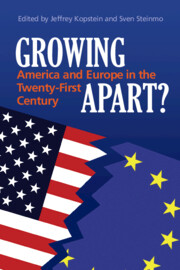Book contents
- Frontmatter
- Contents
- Contributors
- Acknowledgments
- Growing Apart?
- Introduction: Growing Apart? America and Europe in the Twenty-First Century
- 1 The Religious Divide: Why Religion Seems to Be Thriving in the United States and Waning in Europe
- 2 Value Change in Europe and North America: Convergence or Something Else?
- 3 On Different Planets: News Media in the United States and Europe
- 4 One Ring to Bind Them All: American Power and Neoliberal Capitalism
- 5 Spreading the Word: The Diffusion of American Conservatism in Europe and Beyond
- 6 Work, Welfare, and Wanderlust: Immigration and Integration in Europe and North America
- 7 Lost in Translation: The Transatlantic Divide over Diplomacy
- 8 The Atlantic Divide in Historical Perspective: A View from Europe
- Index
6 - Work, Welfare, and Wanderlust: Immigration and Integration in Europe and North America
Published online by Cambridge University Press: 19 January 2010
- Frontmatter
- Contents
- Contributors
- Acknowledgments
- Growing Apart?
- Introduction: Growing Apart? America and Europe in the Twenty-First Century
- 1 The Religious Divide: Why Religion Seems to Be Thriving in the United States and Waning in Europe
- 2 Value Change in Europe and North America: Convergence or Something Else?
- 3 On Different Planets: News Media in the United States and Europe
- 4 One Ring to Bind Them All: American Power and Neoliberal Capitalism
- 5 Spreading the Word: The Diffusion of American Conservatism in Europe and Beyond
- 6 Work, Welfare, and Wanderlust: Immigration and Integration in Europe and North America
- 7 Lost in Translation: The Transatlantic Divide over Diplomacy
- 8 The Atlantic Divide in Historical Perspective: A View from Europe
- Index
Summary
Europe and North America have long diverged in their immigration policy. Simply put, Europe was from the early 1800s until the 1950s a continent of emigration, whereas the United States and to a lesser degree Canada were quintessential countries of immigration. Canada and the United States encouraged Northern European immigration with the goal of building white, Anglo-Saxon settler societies; Europe encouraged emigration with the goal of exporting surplus population and unemployment (Germany, Italy) and/or empire building (the United Kingdom). In the postwar years, divergence continued. The United States and Canada abandoned the race-based, exclusionary inflection of their immigration policies, and opened their doors to an extraordinary migration from East and South Asia, the West Indies, Latin America, and Africa. European nation-states tried to have their cake and eat it too: They tried to harness the economic benefits of mass unskilled labor while ensuring that the migration was temporary. These efforts largely failed: The liberal constitutional order that is common to Europe and North America meant that the immigrants were not simply workers but rights-bearers, and European courts frustrated national efforts to guarantee the migrants' return.
The result, by the 1990s, was a demographic makeup that looked broadly similar on both sides of the Atlantic. European and North American societies were multi-ethnic; the bulk of migrants and ethnic minorities lived in their cities; and (with Canada partially excepted) the migration patterns were dominated by family reunification.
- Type
- Chapter
- Information
- Growing Apart?America and Europe in the 21st Century, pp. 170 - 191Publisher: Cambridge University PressPrint publication year: 2007
- 1
- Cited by



